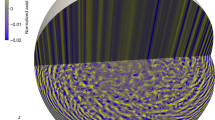Abstract
The aim of this work is to present a transport process which is likely to have a great importance for the internal constitution of the stars. In order to set the problem, we first give a short presentation of the physical properties of the Sun and stars, described usually under the names of `Standard Solar Model' or `Standard Stellar Models' (SSM). Next we show that an important question about SSM is that they do not explain the age dependance of lithium deficiency of stars of known age: stars of galactic clusters and the Sun. It has been suggested a long time ago to assume the presence of a macrosocpic diffusion process in the radiative zone, below the surface convective zone of solar like stars. It is then possible for the lithium present in the convective zone to be carried to the thermonuclear burning level below the convective zone. The first assumption was that differential rotation generates turbulence and therefore that a turbulent diffusion process takes place. However, this model predicts a lithium abundance which is strongly rotation dependant, contrary to the observations. Furthermore, the diffusion coefficient being large all over the radiative zone, it prevents the possibility of gravitational separation by diffusion and consequently leads to an impossibility of explaining the difference of helium abundance between the surface and the center of the Sun. The consequence is obviously that we need to take into account another physical process. Stars having a mass M < 1.3 M ⊙ have a convective zone which begins close to the stellar surface and extends down to a depth which is an appreciable fraction of stellar radius. In the convective zone, strong stochastic motions take care, at least partially, of heat transfer. These motions do not vanish at the lower boundary and generate internal waves into the radiative zone. These random internal waves are at the origin of a diffusion process which can be considered as responsible of the diffusive transport of lithium down to the lithium burning level. This is certainly not the only physical process responsible of lithium deficiency in main sequence stars, but its properties open the way to a completely consistent analysis of lithium deficiency. The model of generation of gravity waves is based on a model of heat transport in the convective zone by diving plumes. The horizontal component of the turbulent motion at the boundary of the convective zone is supposed to generate the horizontal motion of internal waves. The result is a large horizontal component of the diffusion coefficient, which produces in a short time an horizontal uniform chemical composition. It is known that gravity waves, in the absence of any dissipative process, cannot generate vertical mixing. Therefore, the vertical component of the diffusion coefficient is entirely dependant of radiative damping. It decreases quickly in the radiative zone, but is large enough to be responsible of lithium burning. Due to the radial dependance of velocity amplitude, the diffusion coeficient increases when approaching the stellar center. However, very close to the center, non-linear dissipative and radiative damping of internal waves become large and the diffusion coefficient vanishes at the very center. The development of this abstract can be found in E. Schatzman (1996, J. Fluid Mech. 322, 355).
Similar content being viewed by others
Author information
Authors and Affiliations
Rights and permissions
About this article
Cite this article
Schatzman, E. Effect of Gravity Waves on Transport Process in Stellar Radiative Region. Astrophysics and Space Science 265, 97 (1999). https://doi.org/10.1023/A:1002153914679
Issue Date:
DOI: https://doi.org/10.1023/A:1002153914679




